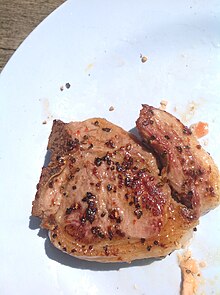Healthy eating habits/Healthy eating for East Asia Student in Australia
Australia is a popular destination for overseas tertiary study with many East Asian students coming from Malaysia, Taiwan, Hong Kong, Japan and Korea. As an international student and living away from home, you are responsible for your own diet and may need to do your own shopping and cook by yourself. It is a good time to develop life-long healthy eating habits. The Australian Guide to Healthy Eating is a good starting point for information about healthy eating.

What is the Australian Guide to Healthy Eating?[1]
[edit | edit source]The Australian Guide to Healthy Eating provides you with advice and guidelines about healthy foods and the amount you should consume on a daily basis. It has five guidelines.
Guideline 1
[edit | edit source]To achieve and maintain a healthy weight, be physically active and choose amounts of nutritious food and drinks to meet your energy needs.
- You may be busy with study but don't forget physical activities. Spending half an hour(return) riding a bike or walking to school may help you stay fit.
- Try playing sports with friends on the weekends to be social and active.
.
Guideline 2
[edit | edit source]Enjoy a wide variety of nutritious food from these five food groups every day.
- Vegetables and legumes/beans,
- Fruit,
- Grain (cereal) foods, mostly wholegrain and/or high cereal fibre varieties,
- Lean meat and poultry, fish, eggs, tofu, nuts and seeds, and legumes/beans,
- Milk, yoghurt, cheese and/or alternatives, mostly reduced fat
Guideline 3
[edit | edit source]Limit intake of foods containing saturated fat, added salt ,added sugars and alcohol.
- butter, cream, palm oil, deep fried food contains saturated fat which is bad to health.
- Use pepper, spices, garlic, onion or lemon as taste ingredients to reduce salt added.
- Soft drinks, sport drinks, and chocolate bars may have added sugar that give you excess energy.
- Limit alcohol to 2 standard drinks. 1STD=1 can of 375ml beer or 1 glass of wine (125ml).
Guideline 4
[edit | edit source]Encourage, support and promote breastfeeding
Guideline 5
[edit | edit source]Care for your food; prepare and store it safety
- Keep the fridge and cooking area clean
- Be careful of cross contamination between raw and cooked food
- Look for best-before / use-by date for package food
Knowing the number of serves we need and tips for counting
[edit | edit source]Vegetables, legumes and beans
[edit | edit source]
men: 6 / women: 5 serves
- 1/2 cup cooked or 1 cup raw green/ orange vegetables
- 1 cup kimchi
- 1/2 starchy vegetables (potato)
- 1 medium tomato
Fruit
[edit | edit source]Men & women : 2 serves
- 1 medium apple, banana, orange, pear
- 2 small apricots, kiwi fruits or plums
- 1 cup dried/ canned fruit
- 1 hand-fold of dried food
Grain (cereal) foods, mostly wholegrain and/or high cereal fibre varieties
[edit | edit source]Men and women: 6 serves

- 1 slice of bread
- 2 medium size sushi roll
- 1/2 cup cooked rice, pasta, noodles, polenta
- 2/3 wheat cereal flakes
- 1 small bun/ steamed bread
Lean meat and poultry, fish, eggs, tofu, nuts and seeds, and legumes/beans
[edit | edit source]Men: 3/ women: 2.5 serves


- 1 piece (65g)of red meat (pork, beef or lamb)
- 1 piece (80g) of cooked poultry
- 1 (100g) cooked fish fillet
- 1/2 cup of tofu
- 2 large eggs
- 1 hand-fold of nuts
Milk, yoghurt, cheese and/or alternatives
[edit | edit source]Men and Women: 2.5 serves
- 1 cup (250ml) milk/soy milk with added Calcium
- 2 slices of hard cheese
- 1 cup of yoghurt (200g)
- 60g canned sardines
- 1/2 cup tofu
Tips for counting number of serves easily
[edit | edit source]- Use mobile apps for recording
- Note the weight of packaged food you eat.
- For large packages, you may need to count the number of times you need to finish the product
- Take note of the bowl size used at home
Smart Tips when eating out
[edit | edit source]Chinese, Vietnamese, Thai and Malaysian cuisine
[edit | edit source]- Choose grilled or steamed instead of deep fried and pan fried
- Reduce sugar options for drinks
- Skin off for fatty meat
- Use less soy sauce
- Include vegetables in each meal
Korean and Japanese Restaurant
[edit | edit source]- Grilled chicken BBQ instead of pork belly
- Bibimbap instead of BBQ
- Seafood/ vegetable soup is a good option
- Fish sushi instead of tempura sushi
- Cold noodle is a good choice.
Fast food shop
[edit | edit source]- Grilled chicken burger instead of deep fried or beef burger
- Chicken salad is a good choice
- Low fat and low sugar options are also available at most fast food shops
Find more information about AGHE or healthy eating
[edit | edit source]dietitians Association of Australia
References
[edit | edit source]NHMRC. (2013). Australian Guide to Healthy Eating. Retrieved from http://www.eatforhealth.gov.au/sites/default/files/files/the_guidelines/n55a_australian_dietary_guidelines_summary_131014.pdf
- ↑ Australian Dietary Guidelines. Department of Health and Aging. NHMRC (2013). Australian dietary Guidelines. Retrieved from http://www.eatforhealth.gov.au/guidelines/australian-guide-healthy-eating